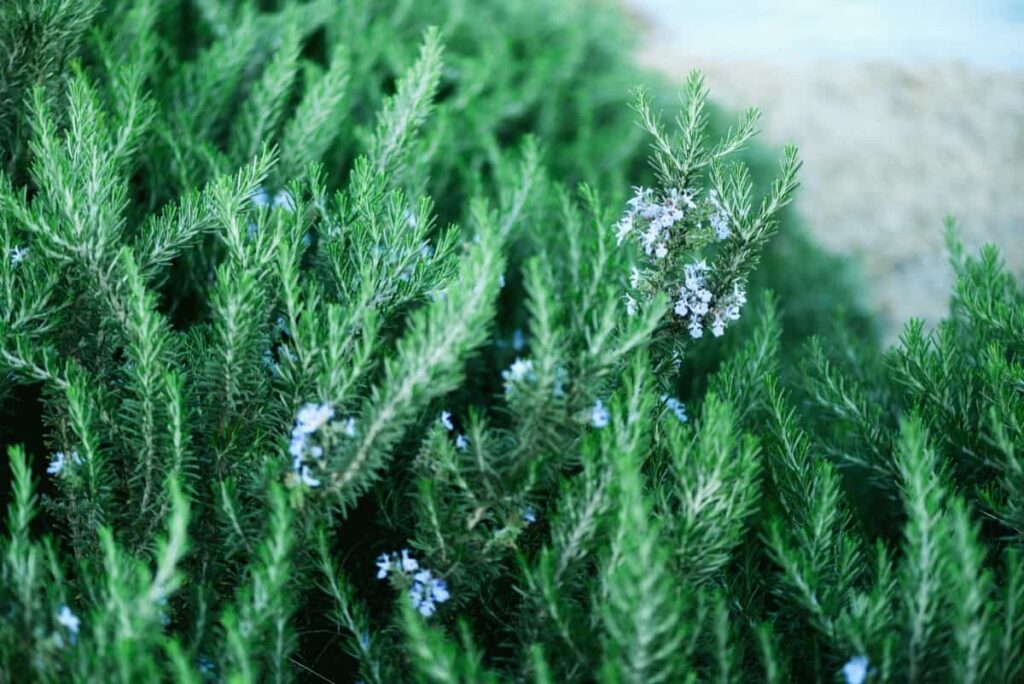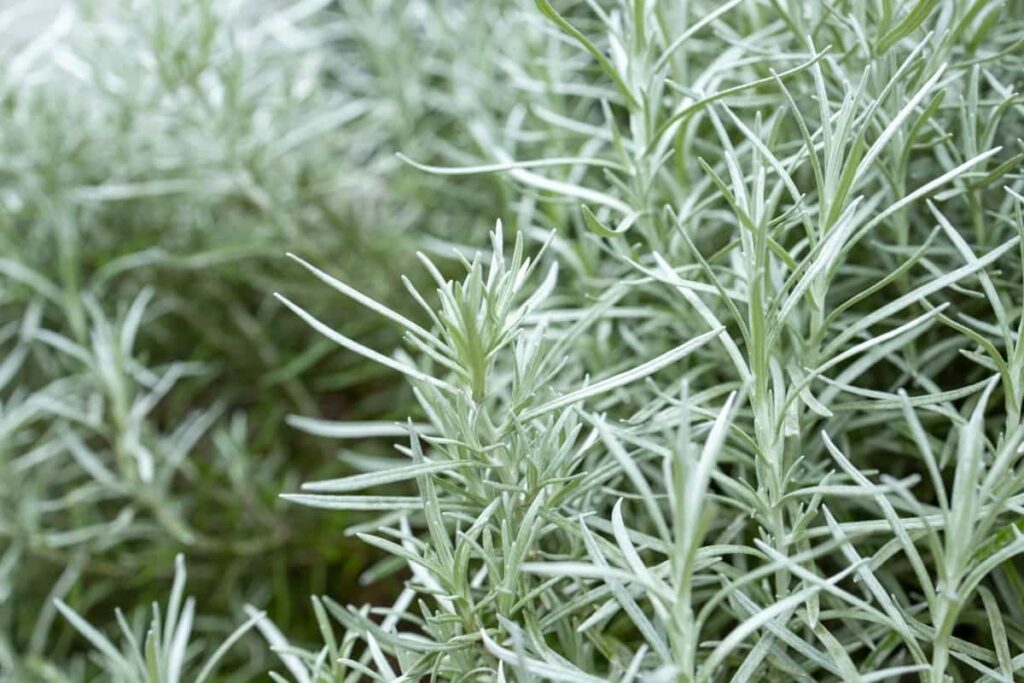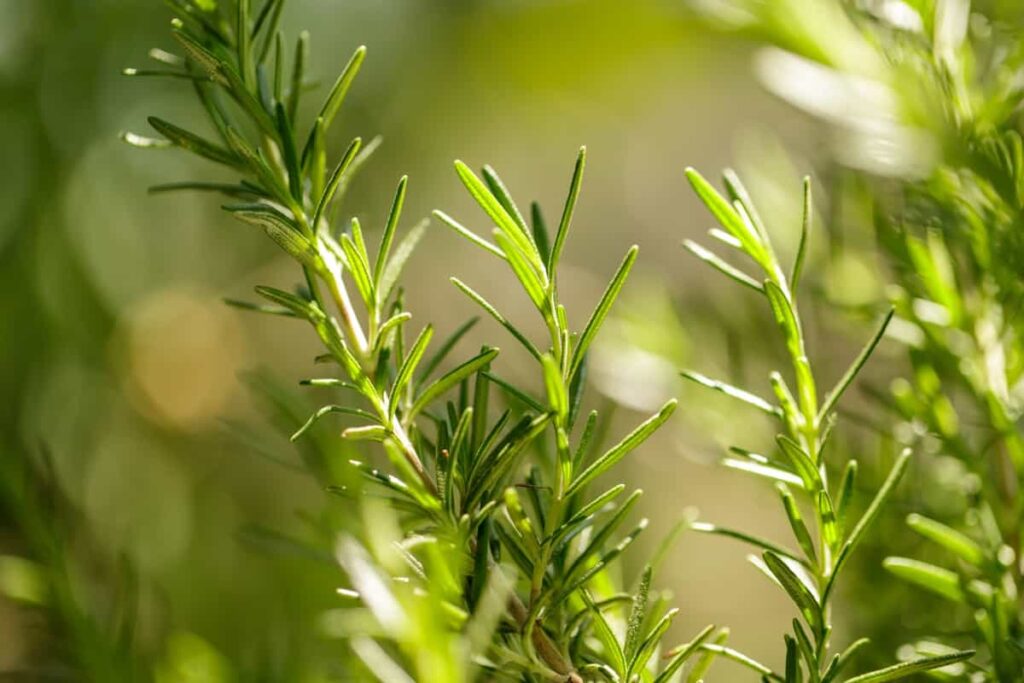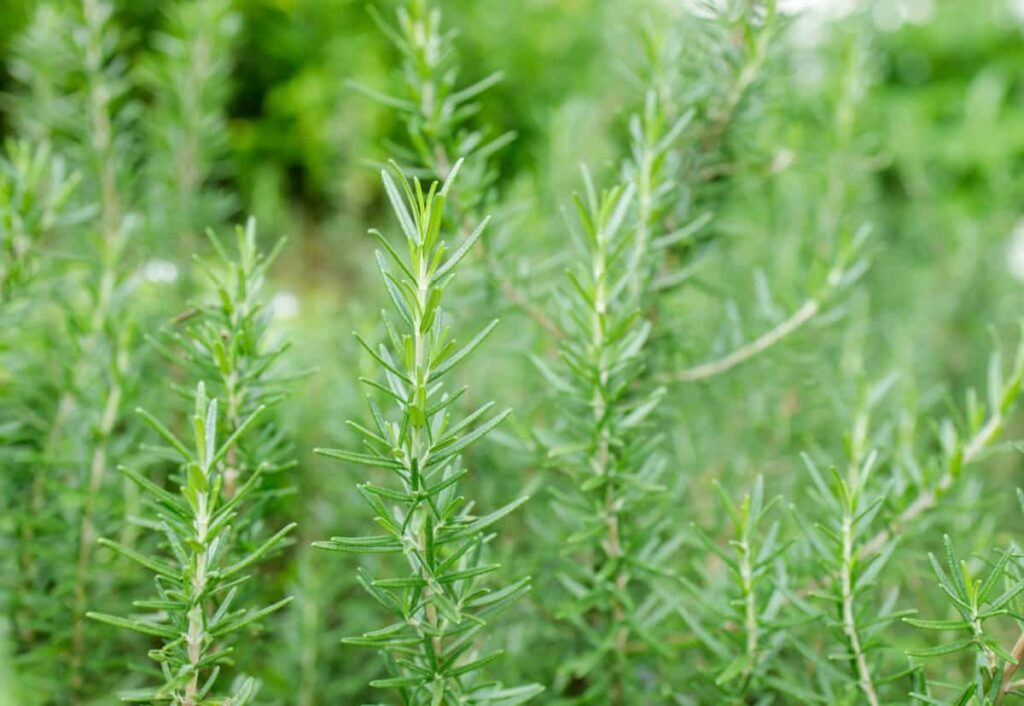Rosemary, a perennial herb with a unique aroma and flavour, has been used for culinary and medicinal purposes for centuries. With its growing popularity, rosemary farming has become a lucrative business venture for many farmers and entrepreneurs. This blog will provide a step-by-step guide on starting and running a successful rosemary farming business, including selecting the right location and soil preparation for planting, harvesting, and marketing your herbs.

Rosemary Farming Business Plan
Introduction to the Rosemary
Rosemary (Salvia rosmarinus) is a fragrant, evergreen shrub with needle-like leaves and white, pink, purple, or blue flowers. This plant is a native origin to the Mediterranean region and belongs to the Lamiaceae family, which includes many other herbs used for cooking and medicine.
The name “rosemary” is Latin “ros marinus,” meaning “dew of the sea.” It has a fibrous root system and can grow up to 1.5 meters tall in upright forms or trail along the ground in trailing forms. The leaves are evergreen, 2-4 cm long and 2-5 mm broad, green on top and white below, with dense, woolly hair. It blooms in spring and summer in temperate climates but can flower year-round in warm climates. Rosemary is drought-resistant and can survive for up to 30 years.
Benefits of Rosemary Farming
- Health Benefits: Rosemary contains antioxidants and anti-inflammatory compounds that may help boost the immune system, improve digestion, and reduce inflammation. It is also believed to improve memory and cognitive function.
- Culinary Uses: Rosemary is a popular herb in many cuisines, adding flavour and aroma to dishes such as roasted meats, soups, and stews. It can also be used to make tea and infused oils.
- Aromatherapy: The scent of Rosemary is believed to have a reduced effect and can help reduce stress and anxiety. It is often used in aromatherapy and essential oil blends.
- Profitable Business: Rosemary is a high-value crop with strong demand from the culinary and cosmetics industries. With proper care and cultivation, rosemary farming can provide a source of income for farmers and small business owners.
How to Grow Rosemary for Commercial Production
Growing Rosemary requires well-draining soil, plenty of sunlight, and regular watering. Rosemary can be propagated through cuttings or seeds. With appropriate maintenance, rosemary plants can yield a plentiful harvest for many years. Harvesting should occur before flowering, and leaves should be carefully dried to maintain flavour and perfume.
In case you missed it: How to Grow Desert Roses: Varieties, Soil, Planting, Pruning, Fertilizers, and Care

Popular Rosemary Varieties for Commercial Cultivation
- Tuscan Blue: A tall, upright variety with blue flowers and a strong aroma.
- Arp: A cold-hardy variety that can withstand temperatures as low as -10°F. It has grey-green foliage and a mild flavour.
- Salem: A popular variety for its high oil content, intense flavour, and attractive blue flowers.
- Barbecue: A dwarf variety with a strong, spicy flavour that is great for grilling.
- Blue Spire: A tall, upright variety with deep blue flowers and a strong aroma.
- Gorizia: A compact variety with narrow leaves and a strong flavour.
- Spice Island: A fast-growing variety with a strong flavour, aroma, and blue flowers.
Tips for Growing Rosemary and Commercial Production
- Site Selection: Select well-drained sandy loam soil, but it can also be grown in clay loam soil with less than 25% clay. The ideal pH for good growth of Rosemary is between 5.5 and 8.9.
- Prepare the Soil: Deep ploughing 3-4 times to reach the fine tilth stage. Remove weeds from previous crops and add organic fertilizers while preparing the soil.
- Climate Requirement For Rosemary Farming: Rosemary plants can tolerate hot and cold climates. Thrive best at day temperatures between 20° C and 26° C.
- Best Time for Rosemary Cultivation: Spring is the best time to start rosemary farming.
- Propagation of Rosemary:: Propagation of rosemary plants can be done through stem cuttings, seeds, and layering of roots
- Cutting Propagation: Cuttings from growing stem tips are the most effective and efficient technique to propagate Rosemary. Cut 12 to 15 cm long cuttings, remove the bottom 2/3 of the leaves, and place them in a growth medium. After 3 to 4 weeks, roots will begin to form, and a mist bed with a heated floor can aid in root formation.
- Layer Propagation: Layer propagation can be done in the summer by pegging lower branches under sandy soil/moist soil. Plants can be separated from their parent plant once roots have been formed.
- Seed Propagation: Not recommended for commercial rosemary farming due to slow germination and growth rate of seedlings The problem of cross-pollination for growing true-to-type plants from seed
- Purchase Plants: Purchase ready seedlings from nurseries to avoid the hassle of propagation
- Planting: Rosemary plants require full sun for better growth. Space beds 1-2 meters apart with 40 to 50 cm raw space for machine cutting. A total of 50,000 to 60,000 plants are required per hectare. Water plants immediately after planting in the main field
- Caring and Management in Rosemary: Rosemary plants require less caring and management. Additional care can help the plants grow well, stay healthy, and produce essential oil quality.
- Fertilizing: Add organic fertilizers, Balanced fertilizers of recommended dose while preparing the soil for rosemary farming. Additional application of fertilizers should be made depending on the soil test and Plant growth conditions.
- Watering: Rosemary plants grow well in dry lands. Irrigation is required for commercial rosemary production until roots are well established. Do not allow plants to dry out or over-irrigate. No irrigation is needed if annual rainfall is over 450mm.
- Mulching: Mulching is important for retaining soil moisture and preventing weeds. Organic materials can be used for mulching.
- Controlling Weeds: Regular hand weeding and hoeing to reduce most weeds.
In case you missed it: Guide to Starting a Successful Medicinal Plants/Herbs Farming Business Plan: Tips, Strategies, and Best Practices

Pests & Diseases
- Common pests include spider mites, mealy bugs, thrips, and whiteflies.
- other Common pests and diseases in Rosemary
- Leaf blight, beetles, botrytis blight
- Leaf blight is a fungal disease that causes yellowing and browning of the leaves, while beetles can chew holes in the foliage. Botrytis blight is a grey mould that thrives in humid conditions and can cause wilting and dieback of the plant.
- Applying insecticidal soap with lightweight horticultural oil helps control pests.
- Common diseases include powdery mildew, root rot, and fungal problems.
Harvesting
- Rosemary crops can be harvested once or twice a year, depending on their purpose.
- Leaves are harvested with flowering onset, and flowering tops are harvested with a sickle.
- Mechanical harvesting is preferred. The first cutting can be done in the seeding year but is delayed until 18 months after seeding for better yield.
- Expect an average yield of 30 to 75 kg of essential oil per hectare and 2000 to 2250 kg of dry herb per hectare.
Post Harvesting and Yield in Rosemary
- For the distillation of Rosemary, shoots should be used at maximum size, but hardwood shoots produce a turpentine-like odour before becoming woody.
- The first-year crop is ready for harvest 215 days after planting, and subsequent years allow for three harvests per year at 3-4 month intervals.
- Dried leaves yield 2.5 tons per hectare yearly, while oil yield is 80-100 kilograms annually.
How to Grow Rosemary at Home
Starting Rosemary Plants
- Rosemary plants can be started from seeds or cuttings. Cuttings are recommended for amateurs who only want a few plants.
- Young Rosemary stems of at least 3 inches (8cm) long should be selected during spring.
- Leaves at the bottom half of the cuttings should be removed.
- Cuttings should be placed in a soil mixture of 30% river sand, 30% peat moss, and 40% special soil mix.
- Root hormone may need to be added.
- Cuttings should be watered every other day until the roots begin to grow.
Transplanting Rosemary
- Transplant cuttings after the last frost, preferably during late spring to early summer.
- Young rosemary plants need frequent watering to develop strong roots during their first summer months.
- Be cautious not to over-irrigate, as root rot is a major issue.
- Mature rosemary plants can rely solely on rainfall in areas with at least 450 mm of annual precipitation.
Harvesting Rosemary
- Most farmers and gardeners do not harvest Rosemary stems during the plant’s first year.
- Fresh Rosemary can be harvested all year round from the second year onwards.
Project Report on Rosemary Cultivation
Rosemary cultivation is a profitable agribusiness that involves low investment and high returns. One can establish an acre of rosemary cultivation with a capital investment of INR 254,000 ($3,393). The recurring cost for one year is INR 102,800 ($1,370), including labour, fertilizers, and other chemicals.
In case you missed it: Zone 6 Gardening Guide for Vegetables, Fruits, Herbs, Flowers, and Month-to-Month Calendar

The production of dried leaves after one year is estimated to be 1000 kg per acre, which can be sold at INR 300 ($4) per kg, resulting in a total income of INR 300,000 ($4,000). The total profit after one year would be INR 197,200 ($2,625), making rosemary cultivation a lucrative business opportunity for farmers.
- Capital Investment: This includes all the initial expenses incurred in setting up the rosemary cultivation, such as land digging, fencing, power tiller, soil levelling, storehouse construction, etc.
- Recurring Cost: This includes the cost of labour, fertilizers, and other chemicals required to maintain rosemary plants.
- Total Investment: This is the sum of capital investment and recurring expense, representing the total amount of money invested in the cultivation of Rosemary.
- Total Income: This is the expected income from the sale of dried leaves of Rosemary after one year of cultivation.
- Total Profit: This is the difference between the total income and total investment, representing the profit earned after one year of cultivation.
| Category | Expense (INR) | Expense (USD)* |
| Capital Investment | 254,000 | 3,449.32 |
| Recurring Cost | 102,800 | 1,397.85 |
| Total Investment up to 1 year | 356,800 | 4,847.17 |
| Total Income | 300,000 | 4,081.63 |
| Total Profit after one year | 197,200 | 2,682.46 |
Rosemary Farming Business Plan
Rosemary farming is an excellent business opportunity for individuals looking to venture into the agricultural sector. This aromatic and medicinal herb has a high demand in the market due to its various applications in the food, cosmetics, and pharmaceutical industries.
Rosemary is a perennial shrub that requires minimal care and maintenance, making it ideal for small-scale farmers. With a capital investment of approximately INR 356,800 ($4,700), one can expect a yield of 1000 kg of dried leaves per acre after one year. With a selling price of INR 300 ($4) per kg, rosemary farming can generate significant profits for farmers.
Business Plan Components of Rosemary Business
- Executive Summary: This component provides an overview of the Rosemary farming business, including the business’s goals, objectives, and strategies.
- Market Analysis: This section analyses the Rosemary market, including the demand for Rosemary, pricing trends, and competition.
- Marketing and Sales Strategy: This section outlines the strategies the business will use to market and sell its Rosemary products, such as developing a solid brand identity, identifying target customers, and creating effective marketing campaigns.
- Operational Plan: This section outlines the day-to-day operations of the Rosemary farming business, including land preparation, planting, irrigation, fertilization, pest control, and harvesting.
- Financial Plan: This section includes projections for the Rosemary farming business, such as start-up costs, cash flow projections, and projected income and expenses.
- Management Team: This section describes the management team and their roles and responsibilities, including the experience and qualifications of each team member.
Each of these components is crucial for the success of a commercial Rosemary farming business. A well-written business plan will provide a roadmap for the business owner to follow, help secure financing, and attract investors or partners.
In case you missed it: How to Start Polyhouse Farming from Scratch: For Vegetables, Flowers, and Herbs

Market Research and Analysis
Market research and analysis play a crucial role in determining the success of a rosemary farming business. The global rosemary extracts and oil market is expected to increase significantly due to the increasing demand for natural and herbal products. The cosmetic and personal care industry is one of the most significant users of rosemary extracts due to their anti-inflammatory and antioxidant properties.
The food and beverage industry is also a major consumer of rosemary extracts due to their preservative and flavouring properties. The demand for organic and natural products is expected to boost market growth further. Researching the target market, demand and supply dynamics, competition, pricing, and customer preferences are essential to develop a successful business plan.
Conclusion
Growing Rosemary has the potential to be an income-generating project. Farmers can succeed in this field by following the procedures provided in this business plan, including proper land preparation, irrigation, and marketing tactics. With an increasing demand for natural and healthful products, rosemary farming can be profitable for anyone wishing to start or develop their agricultural business.
- Profitable Village Farming Business Ideas in 2024
- High-Yield Aquaculture: Fast-Growing Fish for Farming
- Effective Fish Pond Construction Techniques for Beginners
- Irrigation and Water Management in Pineapple Farming
- Blossom to Harvest: Mastering Flowering and Pollination in Papaya Farming
- Pig Fattening Essentials: From Selection to Sale for Beginners
- Raising Wagyu Cattle: A Complete Guide for Premium Beef Production
- Soil Types and Their Water Holding Capacity
- Optimizing Irrigation Schedules for Coconut Groves for Enhanced Yield
- Espresso Your Garden: Coffee Grounds for Healthier Acid-Loving Plants
- The Best Soil Mix for Snake Plants: How to Mix Your Own Snake Plant Soil
- Green Thumb Success: Expert Tips for Cultivating Greenhouse Beans All Year Round
- Bloom All Year Round: The Ultimate Guide to Indoor Hyacinth Care
- Eco-Friendly Gardening: How to Make Liquid Fertilizer from Kitchen Waste
- Ultimate Guide to Grow Anise in Pots: Explore Seed Propagation to Harvesting
- Guide to Raising Chester White Pigs: Discover Breed Facts to Growth Management
- Mastering the Elegance: The Ultimate Guide to Weeping Cherry Tree Care, Planting, and Maintenance
- Ultimate Guide to Planting Garlic in Grow Bags: Growing Strategies for Beginners
- How to Fix Spider Plant Leaf-Related Problems: Natural and Organic Remedies
- 10 Reasons Why Your Tulsi Plant is Shedding Leaves: Home Remedies and Solutions
- Optimizing Growth and Yield: The Advantages of Palm Bunch Ash Fertilizer
- Utilizing Neem Oil Extract as a Natural Pesticide for Hydrangea
- From Soil to Harvest: Various Ways in Which Farmers Can Use AI Tools
- Steps to Encourage and Induce Citrus Flowers: A Comprehensive Guide
- How to Fix Snake Plant Leaf-Related Issues: Natural and Organic Remedies
- Transform Your Garden into a Fragrant Oasis with Raat Ki Rani (Night Blooming Jasmine)
- Discover the Ideal Chicken Breeds for Philippine Farms
- How to Create a Poultry Egg Farm Business Plan for Profits
- Grow Lemon Cucumbers Like a Pro: Insider Techniques for Bountiful Yields
- Ultimate Guide to Caring for Your Pink Princess Philodendron: Tips for Thriving Variegation
- Areca Nut Profit Per Acre: Calculating Yield and Cost of Cultivation
- How Kaveri Chicken is Becoming a More Profitable Breed in Indian Backyards
- Transform Your Barn: 9 Steps to Convert a Horse Stall into a Chicken Coop
- Exploring Suffolk Sheep Disadvantages with Limitations and Challenges
- Guide to Solving Potted Lemon Tree Problems: How to Revive Lemon Tree in Containers
- Steps to Encourage Female Pumpkin Flowers: Best Strategies for More Flowers and High Yields
